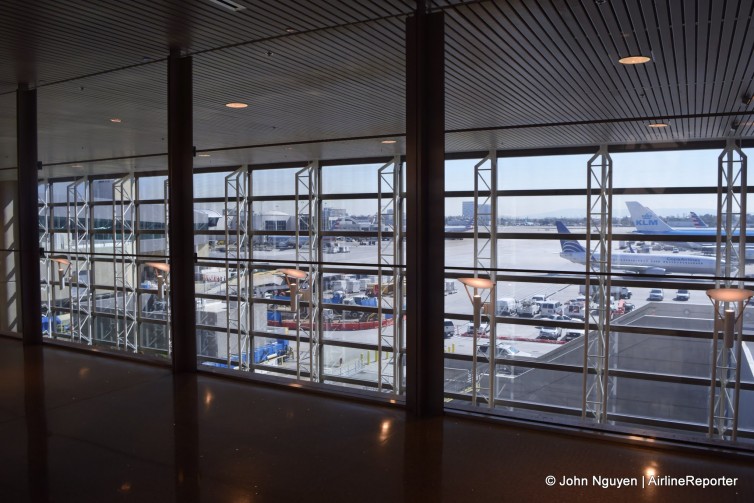
T4-TBIT connector at LAX: Overlooking the ramp between TBIT and T4 at LAX
A couple of weeks ago, I was one of the first to report on the opening of the new Connector facility between Terminal 4 (T4) and the Tom Bradley International Terminal (TBIT) at Los Angeles International Airport (LAX). While this is exciting news in my world, I will admit that sometimes I forget that not everyone is a frequent-flying fanatic or even an #AvGeek. So here I am, to make the case to the everyday person on the street on just why the new T4 Connector is so monumental to the improvement to the passenger experience at LAX.
A bit overly dramatic? You be the judge…
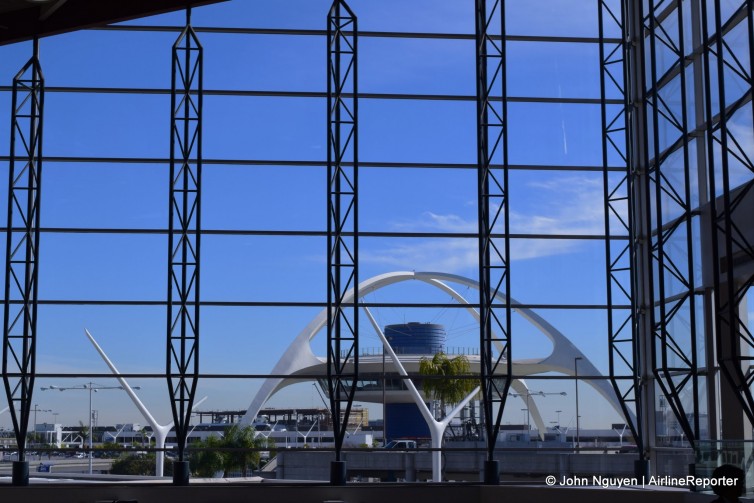
The view of LAX’s Theme Building from the Terminal 2 atrium
LAX Story: What are the Chances of Flying through LAX?
Pretty good, actually. In 2015, LAX was the seventh-busiest airport in the world with almost 75 million passenger boardings, and second in North America, behind Atlanta. Being the largest North American gateway to the Pacific, 28% of those passengers were on international trips. Additionally, LAX ranks first for “O&D” or originating and departing passengers, meaning more people either start or stop their trips at (instead of connecting through) LAX than anywhere else in the world.
Over 12 million international passengers departed last year from TBIT alone. Also telling are the nearly 7.6 international million passengers who departed from Terminals 4-7, and the 54 million domestic passengers overall who departed from LAX in 2015. That’s a whole lotta people to take care of and keep happy, at least long enough to empty their wallets while waiting for their flights.
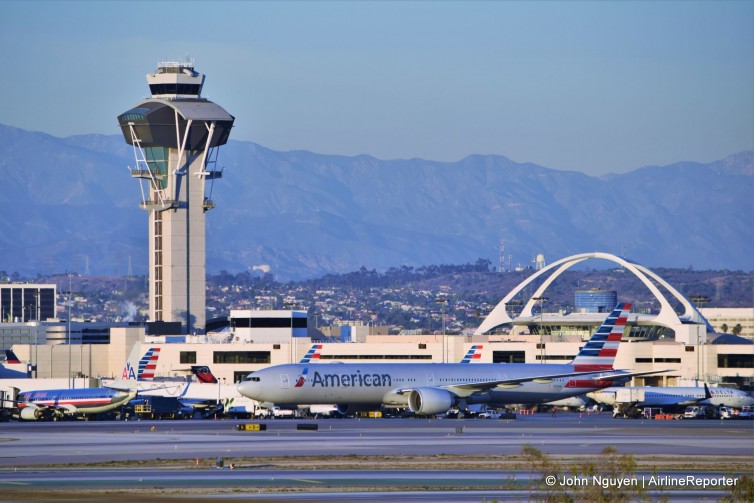
An American 777-300ER taxis the control tower and theme building at LAX
LAX Story: A Sordid History
You don’t have to dig too far back to find articles bemoaning LAX as a subpar international gateway, and reviews slamming it for poor conditions. The airport was a frequent member of various “Worst 10” lists, no matter whether it was a national or international list. One reviewer perceptively stated that the experience at LAX was “a terrible first impression for millions of visitors to the U.S. every year.”
Even LAX’s operator, the Los Angeles World Airports (LAWA) authority, feared in 2007 that its antiquated and dilapidated facilities circa 1961 may scare expanding carriers and “discretionary travelers” away to other U.S. gateways, like San Francisco International Airport and its modern International Terminal completed in 2000. The estimated loss of economic activity to the region if those flights didn’t land at LAX? $6.9 billion.
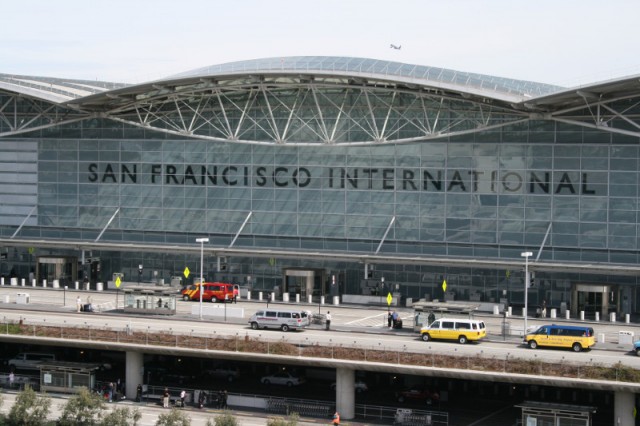
The International Terminal at SFO – Photo: FlySFO
The airport’s layout was conceived at the dawn of the jet age, but is restrictive in today’s world. Traffic congestion through LAX’s U-shaped bi-level roadway is a constant thorn in visitors’ backsides (not to mention to nearby residents, as evidenced by their countless lawsuits). Until fairly recently, each of the eight terminals were isolated from one another, creating headaches for travelers needing to connect to another airline, requiring them to exit their building, get to the next, and reclear security again. While some individual terminals were updated in a piecemeal fashion by the airlines themselves (such as T4, which was built in 1961 and renovated in 2002 at a cost of $300 million, paid by its primary tenant, American Airlines), others were largely untouched and falling into a state of disrepair. Even TBIT was known for its dark, depressing cramped quarters and long lines; not exactly a great start to an anticipated international trip, nor a welcoming sight to visiting foreigners and returning citizens.
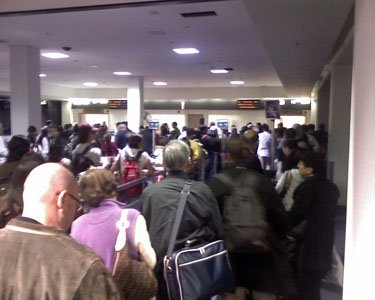
Passengers crowd at one of the gates at LAX’s International Terminal waiting to board, circa 2009 – Photo: John Nguyen | AirlineReporter
LAX Story: Looking to the Future (and One-Upping the Competition)
Faced with the reality of falling behind the modern world, in 2010 the City of Los Angeles launched a then-$4.11 billion plan to modernize the airport, the largest public works project in the city’s history. A new TBIT was the centerpiece of the project, with plans to demolish the existing concourses to make way for a completely new $1.5 billion building. Also envisioned were updates to all the terminal buildings to surpass industry standards, as well as create a new system of moving passengers to deal with the traffic issues.
After three years of construction activity and disruptions to airport operations, the new TBIT opened in early 2013 with much fanfare, representing a watershed moment for LAX, as it had caught up to the modern times. What was once one of the most dreaded gateways in the developed world became one of the best international terminals in North America. Sure, it doesn’t have Singapore’s swimming pool or Hong Kong’s IMAX movie theater, but TBIT finally had shops and eateries that travelers looked forward to, along with the visual eye-candy that gives travelers that additional opportunity for distraction.

The Tom Bradley International Terminal at LAX, 2016 – Photo: John Nguyen | AirlineReporter
LAX Story: But TBIT Wasn’t for Everyone
However, TBIT was isolated. For most of the post-9/11 era, you could only access the terminal your flight was actually flying out of. In 2014, TSA relaxed the policies to allow passengers, with a same-day boarding pass, to enter any terminal, but they still had to clear security. As TBIT was not physically connected to any other terminal, it was effectively restricted to international passengers only (and even then, only some of them), unless a passenger wanted to go through a generally busy security checkpoint (by the way, TBIT has no TSA PreCheck lanes).
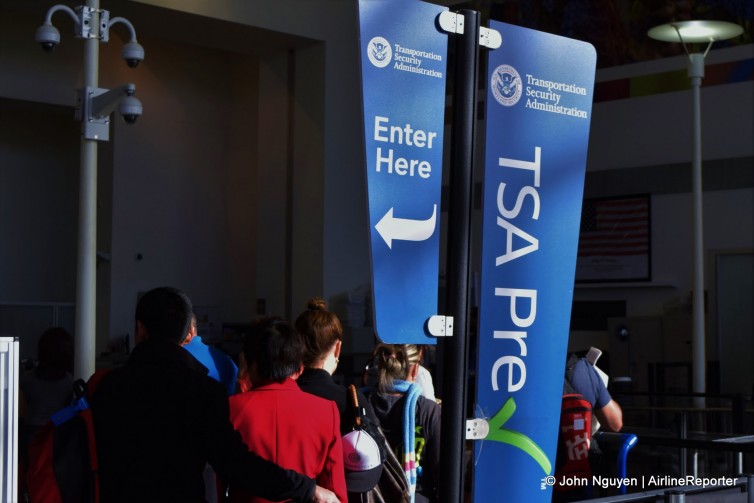
The TSA PreCheck area at LAX Terminal 2
Most of the other terminals were likewise isolated from one another for security purposes. Over the years, however, tunnels and passageways sealed after 9/11 were opened up one by one, to the point where all the terminal buildings in the southern part of the airport (Terminals 4-7) were connected so that passengers didn’t have to leave the secured area, albeit in a maze-like path. Terminals 1-3 to the north remain isolated from each other and the rest of the buildings.
LAX Story: Breaking New Ground
Which brings us to why the opening of the Connector project is so vital. Unlike Terminals 4-7, there was no physical connection between T4 and TBIT, aside from the roadway and sidewalk out in front. With LAX bursting at the seams in the face of growing passenger growth and little room to expand usable square footage, the T4-TBIT Connector complex serves as a vital part to the airport’s modernization, giving potentially 75 million yearly passengers more space to spread out, relax, dine, and shop.
%CODE1_tbityt%
With the Connector now open for passengers to walk through, one can walk from the far reaches of Terminal 7 all the way to TBIT’s Grand Hall and back again without having to clear security again, an invaluable convenience for those who have plenty of time to kill while waiting for their next flight at LAX.
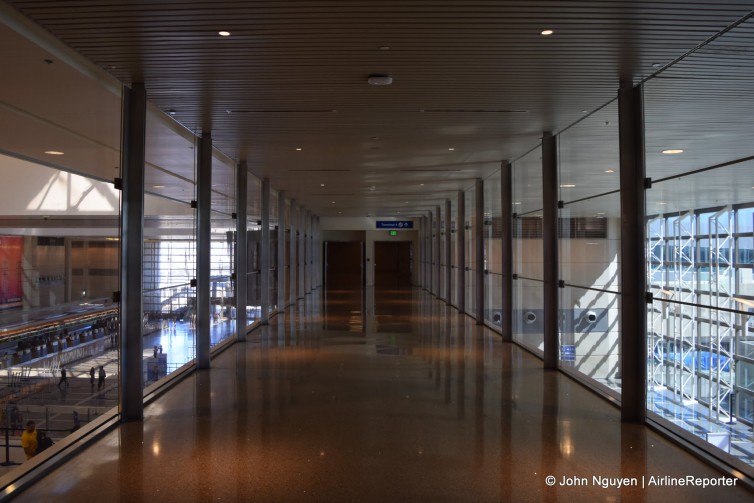
T4-TBIT connector at LAX: A walkway over the check-in counters
For the airlines’ elite and premium passengers, they now have access to the alliance partner lounges at TBIT, some of the best lounges offered stateside. Regular passengers benefit as well, giving them access to a luxury mall managed by Westfield (think Bvlgari, Coach, and Victoria’s Secret) coupled with high-end dining featuring some of Los Angeles’ favorites (like Umami Burger, ink.sack, and Vanilla Bake Shop). There’s even a Starbucks Evenings on site, serving coffee, beer, wine, and tapas. Additional retail and dining will be located in the Connector itself, as well as an outdoor patio to catch some golden rays.
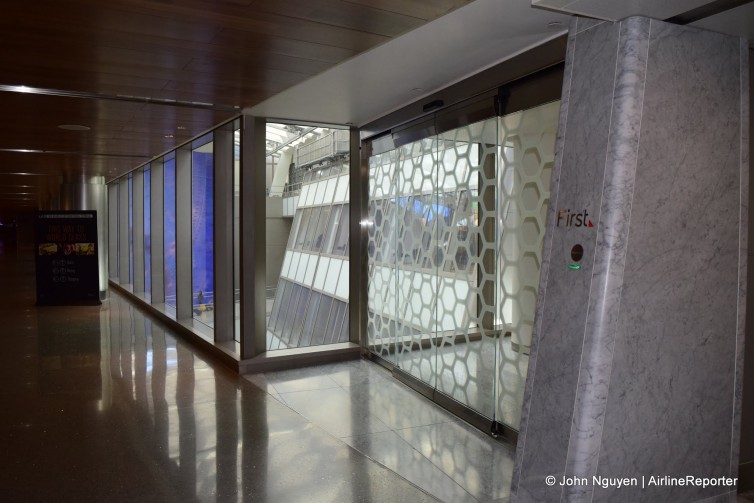
The Oneworld/Qantas First Class Lounge is located at the International Terminal-end of the new airside connector to Terminal 4
The Connector benefits passengers going both ways; passengers departing from TBIT are no longer stuck with nearby options, and can fill their cravings for Real Food Daily in T4, Ford’s Filling Station or Lemonade in T5, The Habit in T6, or The Counter in T7, just to name a few. Likewise, LAWA has been investing in and updating each terminal, with T2’s grand opening just a few weeks ago and substantial active construction going on at T1 and T6.
Also, Terminals 1-3 won’t be isolated for long; a fully-functioning Connector will include a bus pavilion that will connect to the north complex behind security, as well as to south complex buildings for those who don’t want to walk the distance. Eventually, according to LAX’s master plans, all of the terminals, boasting their own improvements, will be linked behind security in one way or another.
While LAX is spending an inordinate amount of money, it’s viewed as an investment into the future. Or cynically, one could say that LAX’s hand was forced to upgrade to keep up with the competition. Either way, these improvements were long overdue and necessary, and the passengers can rejoice in not having to wait out their flights in aging, worn concourses.
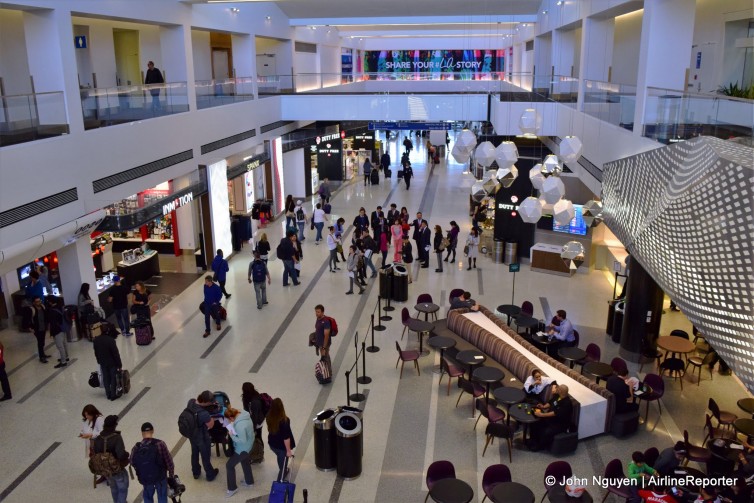
The overhead view of LAX’s Terminal 2 just before the February 2016 grand opening
Well written John. I remember taking a short hop WN LAX-SJC flight about 6 years ago and it was a complete chaotic mess from the condition to the terminal building, curbside, security, right to the gate. SFO’s terminal was still new at the time, and a complete 180 in contrast.
While this connector bridge may not improve this experience directly, I am pleased there are improvements to LAX, and given the fact Skytrax ranks many US airports so poorly your same arguments applies across the US, and only highlights the lack of meaningful infrastructure investment across the board and country.
Thanks for the reply, Phoenix! T1 is under going a complete makeover right now, so it’s probably even worse than you remember, but when it’s all done it should be pretty fantastic. The new check-in lobby is already open though… plenty of room for passengers.
John | AirlineReporter
Did tbit add precheck yet? Or should I go though terminal 4 precheck and walk the connection to tbit ? Flying lax-Mia-Milan and checking a bag